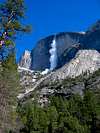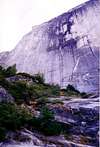|
|
Route |
|---|---|
|
|
37.74610°N / 119.5319°W |
|
|
scramble |
|
|
Half a day |
|
|
class 3-4 |
|
|
Overview
The Slabs route has been accurately described as "devious" in several guide books. It is also great fun and highly adventurous if you're interested in class 3-4 scrambles and aren't in a hurry to get to the top (to start the Regular Route on the NW Face, for example). If you haven't been up this route before, give yourself all day if possible. If you do well you can reach the Half Dome Trail and descend that way, and if need be you can descend the way you went up.There are three locations along this route where you may find fixed ropes. Since it is illegal to leave fixed ropes in Wilderness areas, the NPS removes these from time to time. If present, you must use good judgment rather than blind trust. If you find sections of the rope frayed, consider knotting the rope to make it safer for those who come after you. All of the ropes can be bypassed with class 5.easy climbing or easier. If you are unsure of your solo abilities, carry a rope.
The views that are found along this route are nothing short of outstanding. If you've peered over the top of Half Dome at the NW Face and found it thrilling, you'll likely enjoy the incredible vertigo one gets in staring at it from the bottom. The views behind you to Washington Column, North Dome, Basket Dome and Mt. Watkins are similarly impressive. And you can watch the sightseers move like tiny ants around Mirror Lake far below. Please respect gear that you may find cached at the base of the NW Face - it is not likely abandoned, and climbers high on the wall may be depending on it later.
The description below may or may not be adequate depending on your own route-finding abilities and my abilities to write clearly. Neither Secor nor Reid offer much useful info in their descriptions of this route, but for those that believe more beta is always better, there is an excellent topo of this route that can be found in Chris McNamara's Yosemite Big Walls.
Approach
Hike to Mirror Lake on the maintained trail found on the south side of Tenaya Creek. A short distance past Mirror Lake, you should see a climbers' trail heading south into the woods towards Half Dome. Several good-sized cairns mark the spot, so take the time to look for it. Missing the start is not critical, but it may lead you to more of an adventure than you planned.Route Description
From the maintained trail, follow the climbers' trail south through the woods, up drainages, to the start of the slabs. Look for a faint trail going up and right through the trees on the slabs found at the top of the talus pile. After 80 feet go left where you'll find the first fixed rope. This can be bypassed by climbing a 5th class gully to the left.Above the fixed ropes, climb another 50 feet to a well-defined traverse that goes to the left for several hundred feet. The trail is obvious in this section. When you get to a wide, boulder strewn gully, the route goes up and follows the left side a short way as it makes its way into the next gully to the left. This second gully is the main drainage for the base of Half Dome, and the route follows up this drainage until you reach the base of the NW Face.
Follow many ducks and vestiges of the trail on the left side of the drainage until you come to a short headwall. This is where the second fixed rope is found, going up and to the left. There are two bolts up top to which it is anchored - though this is a trust issue if you are coming from below! The steep wall can be freed in the absence of rope at about 5.5. Alternatively, you can climb the right side of the drainage from here. Sometimes an alternative rope can be found rising to the trees/shrubs on the west wall of the drainage, where a second climbers' trail can be found. For yet a third alternative, a wide, smooth slab on the right side can also be climbed to some shrubs above. This slab steepens gradually and is steeper than it first appears. Some tedious bushwhacking to the left then gets you back to the main trail.
Above the second fixed rope, a useless cairn/trail may be found going immediately to the left. The correct route goes slightly right up and behind the bolts, reaching another set of fixed ropes about 100 feet higher. This third fixed rope section can be bypassed by climbing class 3-4 grass and dirt-filled ledges on the left. Above this, the route is a class 2 slog until you reach the NW Face.
At the base of the NW Face, you have a number of options. Go left, following use trails through the bushes to reach the start of the Regular Route on the NW Face, or further to reach the Half Dome Trail. The Half Dome Trail is farther off than it looks. Behind the high point you can see to the east, you need to travel a similar distance around the North Face of Half Dome before reaching the trail. Alternatively, you can head right (west) from the base of the NW Face towards the Diving Board. This route is longer time-wise, but far more interesting. The chute you see going up is easy class 3 to the top. From there, you must drop down to reach a second gully that goes up to the true notch between Half Dome and the Diving Board. The downclimb is short but tricky, and involves class 4-5.easy climbing depending on which slabs you descend. From this upper notch you can visit the Diving Board (a short way to the west - follow the knife blade ridge here) which is a rather scary proposition to walk out on since its upper surface is badly sloped. Head south to reach the start of Snake Dike. See the Snake Dike route description for more information on descending to the JMT.
Winter/Spring
Winter visits to NW Face can be extremely dangerous due to avalanche conditions. There are three wide, smooth granite bowls along the route that make perfect avalanche chutes. On the other hand, if conditions allow the snow to consolidate, this can be a rather exciting adventure. While the fixed ropes will be buried in winter conditions, the slopes bypassing them are no more than 40-50 degrees and can be climbed in crampons.Well into spring there is often snow existing at the base of the NW Face even when the rest of the route has melted free. In these conditions, climbing to the NW Face is straightforward with the extra caution of wet rock in places, making some of the climbing more difficult. Once at the NW Face, things can get tricky. The snow here is at a steep angle, and may be difficult to traverse. It might be perfect for kicking steps, or it may be hard, icy snow, depending on recent nighttime temperatures. The left side route (towards the Half Dome Trail) is probably safest because a slip mostly will just take you down a hundred feet to the trees/bushes. The right side route has two chutes to manage, both with avalanche danger. The second and highest of the two chutes which leads to the notch requires special attention. An unarrested slip will take you down over a thousand feet to certain death (fall line is down the center of this photo).
A climb of the Slabs to the Diving Board in April is described in this trip report. It was a bit more adventurous than we had planned for due to the sketchy nature of the transition between the two gullies.
There is ample water flowing down the three main bowls into late spring as a bonus. No need to carry water.
Essential Gear
Carry a rope if uncomfortable on class 4-5.easy terrain.Bring axe/crampons for climbs done with snow at the base of the NW Face (Dec - April, typically).










